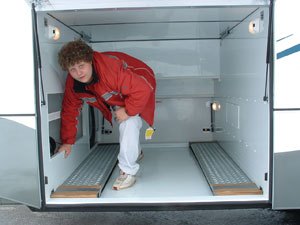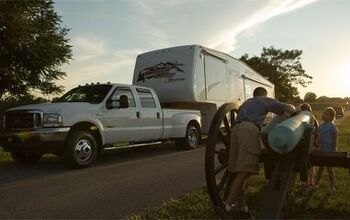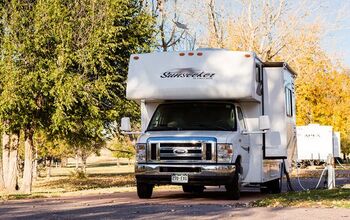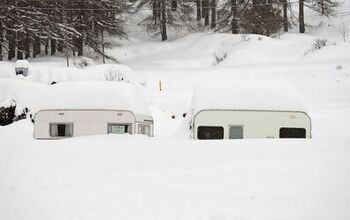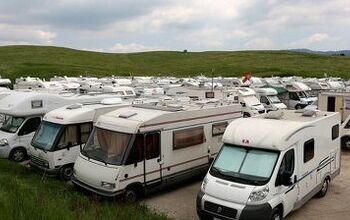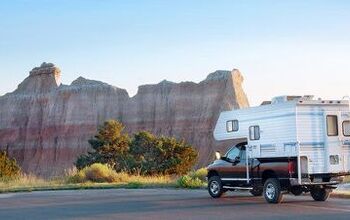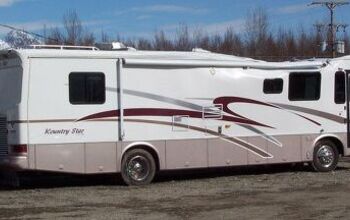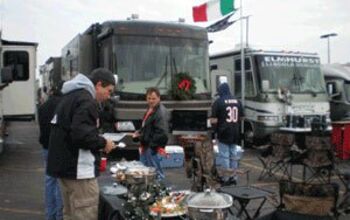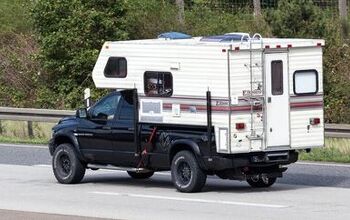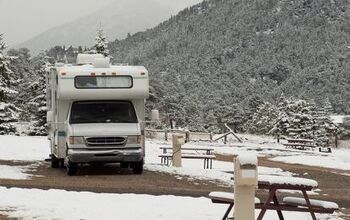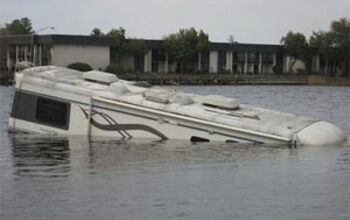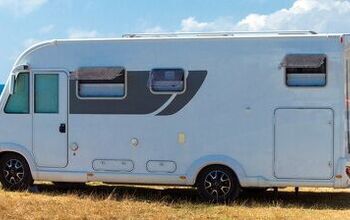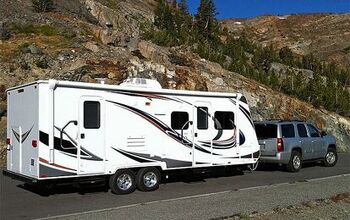2005 Bigfoot 3000-Series Review
Bigfoot Industries is an RV manufacturer based out of British Columbia; one that got its start building truck campers. A few years ago they also began building Class C motorhomes and its one of these that I recently had a chance to test.
Called the 3000-series, this product consists of three lengths (24’ to 30’) and six floorplan configurations, some with slideouts. The unit I tested was the 29G; the G stands for garage. This is a neat feature on this Class C. A built-in garage big enough to house a golf cart, a full size motorcycle, a pair of scooters or a bunch of bikes. For that matter you might load a hot air balloon in there – what you carry is up to you, but the ability to carry something large in the body of the motorhome also lets you haul a trailer.
It comes with a standard Class II hitch receiver; but for those folks who loath towing the garage space may be just big enough to let you get away with never having to pull a trailer. Like I said it opens up a host of possibilities. This garage space has doors that open from either side of the body as well as a roof opening which is part of the pedestal bed setup inside. In addition to the garage there is a front pass-through storage space, and a few other nooks that can be filled. For a motorhome this size storage has been made a priority and it shows.
The Ford E450 which is the base vehicle for this motorhome offers a basic grey interior, but it does have a good center consol, cup holders, a storage bin and door pockets. The transmission is automatic of course and convenience items included in the package are power windows, brakes, steering and tilt wheel. There is also cruise control and an O/D lockout for hilly terrain. In this model the stock seats have been replaced with very nice Flexsteel ones, though with limited space the travel and reclining functions of these seats can not be fully utilized.
The V10 engine has more than enough power to carry this unit and the ride is helped with optional rear air bags (you can set them to a stiffness that accommodates whatever you have in the garage). The downside to this (and virtually all) Class C is the feeling that the unit is wallowing as you drive down the road. There is nothing dangerous in this, it is something though that you have to get used to – it’s simply a function of this type of construction. Otherwise the Bigfoot handled well, braked well and was comfortable to drive.
You should try to remember to flip the overhead bunk open so as not to hit your head getting in and out of the seat. This overhead bunk is quite large and has just over 3’ of clearance, or enough for most folks to sit up comfortably. There are side-windows with screens and an overhead crank up vent. A material pull curtain can make this a private space and a storage space at the head of the bunk would store pillows and or a comforter neatly out of sight.
The dinette that you’ll use to climb into the bunk has a solid feel to it. It also has shoulder belts for travel and the twin bucket chairs across from it also have seatbelts. Though these chairs are bolted to the floor they do swivel and travel using switches in the arms. Between them is a small table that folds down and out of the way. The dinette seats have pullout drawers on each side, while underneath the cushions toward the back there is some storage, but it has to compete with electrical and heating ducts. I noted, with interest, that the framework and seat support of the dinette is steel.
For music there is an optional AM/FM/CD player in the dashboard which is tied into a four speaker house system (two forward, two in the bedroom). These speakers are built into the cabinets with material fronts, invisible.
I was looking for the electrical outlets and wondered why I saw none, till my son noticed that they are mounted on the underside of the cabinets, in the kitchen, over the dinette and the sink.
The placement for the TV in the front of the unit is too small, as is the travel on the pullout stand. The door to this space was droopy and apart from having the cable, ANT and electrical outlets inside this box, I just don’t see wanting my TV in this location. The viewing height is wrong and so is the size.
My tester had an auxiliary heater fan that blew engine heat through two ducts into the body of the motorhome. This worked very well. The engine heater had no problem keeping the unit warm while driving. With this setup there is no need to have the furnace running while in transit or for that matter on short trips where you’re never parked that long. Double pane windows in aluminum frames hold the heat (and they didn’t fog)
Under the sink there is a terminus for waterlines, and electrical. It’s always interesting to see how manufacturers route these services. In this case water lines had square elbows, everything was tied together and down; neat and tidy. Only one problem, there are two cupboard doors here, and it’s obvious that the remaining space is meant to be used for storage; so my first thought was what happens when things start to fall or roll around down there? Without a physical barrier, sooner or later one of those waterlines could get poked and spring a leak. Of course this can be solved by storing loose items in a box under there. This space is under the L-shaped kitchen counter that looks to be very handy for this space. It offers a little more counter using a fold up extension and saves space with a built-in microwave over the stove which also has an exhaust hood. That stove also has an oven. To the left of the stove is a slide-out pantry, perfect to organize canned goods.
The bathroom is set up so as to offer privacy for the occupants of the rear bedroom or the front of the vehicle. Each taking there turn. The rear bedroom has a solid sliding door that separates it from the bath or conversely by locking the toilet door open the front of the motorhome is sealed off. With this door locked open there is access to a built-in wardrobe and a large hall mirror. The shower with overhead skylight also has a ½ tub as its base. The stall is a one-piece format which is neat and tidy, but I noticed when I leaned against it that it requires more bracing on the wall side as it bowed out quite a bit. The toilet faces the sink and cupboard – that’s fine, but then someone got the bright idea to put the toilet paper roll holder inside that cupboard. Well, it would have been a bright idea if the door didn’t collide with your leg when seated.
Outside a clean white surface has applied decals as color and accents. Chrome rims, front and rear also look good as does the chrome (optional) ladder on the rear that leads to the rubber covered roof. The awning (optional) is recessed into the side of the unit – more manufacturers should do this. All the storage doors are lockable, move cleanly and have weather seals. As a unit with a very specific purpose I can see this Bigfoot having distinct advantages.

